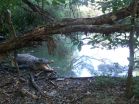Antarctic penguins are subject to extremely low temperatures, high winds, and profound changes in daylight. They have developed complicated biological systems to regulate temperature and store energy for long-term fasting. Most studies have focused on the physiological and behavioral aspects of their biology, but an international team of researchers has now analyzed the DNA of two Antarctic penguins (Adélie and emperor) relative to other bird species, revealing the genetic basis of their adaptations and their evolutionary history in response to climate change.
Using the historical genetic record within the DNA across bird species, the researchers estimate that penguins first appeared around 60 million years ago. The study shows that the Adélie penguin population increased rapidly about 150,000 years ago when the climate became warmer, but later declined by 40% about 60,000 years ago during a cold and dry glacial period. In contrast, the emperor penguin population remained stable, suggesting that they were better adapted to glacial conditions, for example, by being able to protect their eggs from freezing temperatures and incubate them on their feet.
Cai Li, Team Lead at BGI-Shenzhen, China, said: "These different patterns in historical population change also suggest that future climate change may have impacts on the two penguin species. For example, the fact that emperor penguins didn't experience the same population boom as Adélie penguins in warm climates means that they could suffer more from global warming, and this needs to be considered in conservation efforts in Antarctica."
Both penguins were found to have expanded genes related to beta-keratins - the proteins which make up 90% of feathers. They also had at least 13 genes responsible for a single type of beta-keratin, which is the highest number compared to all other known bird genomes. This would explain their importance in ensuring that penguin feathers are short, stiff and densely packed to minimize heat loss, remain waterproof and aid underwater flight. Likely to be responsible for penguins' thick skin, the team also identified a gene called DSG1, which is known to be involved in a human dermatological disease characterized by thick skin on the palms and soles.
Fat storage is critical for penguins to withstand the cold and survive long fasting periods - up to four months in emperor penguins. The two penguins were found to have exploited different adaptations for lipid metabolism in the course of their evolution, which may also provide insight into their contrasting abilities for coping with climate change. The researchers found eight genes involved in lipid metabolism in the Adélie penguin, and three in the emperor penguin.
During their evolutionary history, the wings (or forelimbs) of penguins changed profoundly for wing-propelled diving in the water. The team identified 17 forelimb-related genes in the penguin genomes that had unique changes. One of the genes in particular, EVC2, showed a larger number of genetic changes compared to other birds. Mutations of EVC2 in humans cause Ellis-van Creveld syndrome, characterized by short-limb dwarfism and short ribs.
Guojie Zhang, Assistant Professor at the University of Copenhagen and Associate Director at China National GeneBank, BGI-Shenzhen, China, said: "Penguins show distinct evolution relative to other bird species. They can't fly, have specialized skin and feathers, degenerated wings, and live in a cold environment in which most other birds could not survive. Comparative genomics is a powerful tool for providing answers on the molecular basis of these evolutionary changes and how organisms deal with the conditions they are exposed to. Our study has revealed several of these secrets for the two penguins."
David Lambert, Professor of Evolutionary Biology at Griffith University, Australia, said: "Although Adélie and Emperor penguins both breed on the Antarctic continent, they do so in very different ways. By sequencing the genomes of two penguin species we have been able to compare many of the genes that are responsible for these different abilities to do the same thing - namely to survive and breed in Antarctica. This study is particularly important because it now provides us with the opportunity to conduct large scale evolutionary studies of both species."
These papers are part of a series of reports from the Avian Phylogenomics Project that are being published in concert in multiple journals. The authors of several Science papers will unveil new genomic results related to the avian tree of life, and a number of papers are also published in BMC Genomics, BMC Evolutionary Biology and Genome Biology.
INFORMATION:
Media Contact
Joel Winston
Media Officer
BioMed Central
T: +44 (0)20 3192 2081
E: Joel.Winston@biomedcentral.com
(The Science press package is available at http://www.eurekalert.org/jrnls/sci/. For any queries related to the Science papers, please contact scipak@aaas.org or +1 202-326-6440)
Notes to editor:
Study images of the penguins are available at: http://bit.ly/1FQg6yo
Please credit images as provided in the file names
1. Research article
Cai Li, Yong Zhang, Jianwen Li, Lesheng Kong, Haofu Hu, Hailin Pan, Luohao Xu, Yuan Deng, Qiye Li, Lijun Jin, Hao Yu, Yan Chen, Binghang Liu, Linfeng Yang, Shiping Liu, Yan Zhang, Yongshan Lang, Jinquan Xia, Weiming He, Qiong Shi, Sankar Subramanian, Craig D Millar, Stephen Meader, Chris M Rands, Matthew K Fujita, Matthew J Greenwold, Todd A Castoe, David D Pollock, Wanjun Gu, Kiwoong Nam, Hans Ellegren, Simon YW Ho, David W Burt, Chris P Ponting, Erich D Jarvis, M Thomas P Gilbert, Huanming Yang, Jian Wang, David M Lambert, Jun Wang and Guojie Zhang.
Two Antarctic penguin genomes reveal insights into their evolutionary history and molecular changes related to the Antarctic environment
GigaScience 2014, 3:27
For a copy of this paper or any others that BioMed Central will be publishing from the Avian Phylogenomics Project during the embargo period please contact Joel Winston (joel.winston@biomedcentral.com)
After embargo, article available at journal website here: http://www.gigasciencejournal.com/content/3/1/27
Please name the journal in any story you write. If you are writing for the web, please link to the article. All articles are available free of charge, according to BioMed Central's open access policy.
The collection of avian genome papers will be available here: http://www.biomedcentral.com/series/avian
2. As part of GigaScience's Open Science policies, all of the data from this report are available in GigaDB, and have been since these genomes were completed, prior to article publication to make the sequence information rapidly available to the community. The raw reads are available in the SRA under access numbers SRA129317 and SRA129318.
GigaScience is a BGI-BioMed Central journal that aims to revolutionize data dissemination, organization, understanding, and use. An online open-access open-data journal, it publishes 'big-data' studies from the entire spectrum of life and biomedical sciences. To achieve their goals, the journal has a novel publication format: one that links standard manuscript publication with an extensive database that hosts all associated data and provides data analysis tools and cloud-computing resources.
3. BioMed Central is an STM (Science, Technology and Medicine) publisher which has pioneered the open access publishing model. All peer-reviewed research articles published by BioMed Central are made immediately and freely accessible online, and are licensed to allow redistribution and reuse. BioMed Central is part of Springer Science+Business Media, a leading global publisher in the STM sector. http://www.biomedcentral.com
4. BGI (formerly Beijing Genomics Institute), a China-based scientific institution, is the largest genomic organization in the world. With a focus on research and applications in the healthcare, agriculture, conservation, and bio-energy fields, BGI has a proven track record of innovative, high profile research, which has generated over 178 publications in top-tier journals such as Nature and Science. It also contributes to scientific communication by publishing the international research journal GigaScience and hosting its associated database GigaDB.



